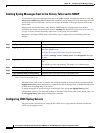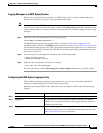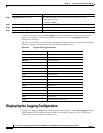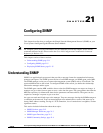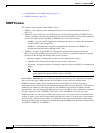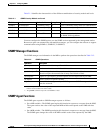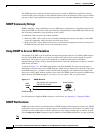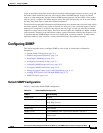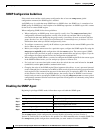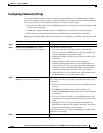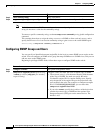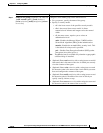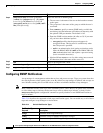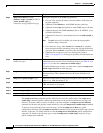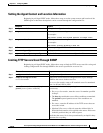
21-6
Cisco Systems Intelligent Gigabit Ethernet Switch Modules for the IBM BladeCenter, Software Configuration Guide
24R9746
Chapter 21 Configuring SNMP
Configuring SNMP
SNMP Configuration Guidelines
If the switch starts and the switch startup configuration has at least one snmp-server global
configuration command, the SNMP agent is enabled.
An SNMP group is a table that maps SNMP users to SNMP views. An SNMP user is a member of an
SNMP group. An SNMP host is the recipient of an SNMP trap operation. An SNMP engine ID is a name
for the local or remote SNMP engine.
When configuring SNMP, follow these guidelines:
• When configuring an SNMP group, do not specify a notify view. The snmp-server host global
configuration command autogenerates a notify view for the user and then adds it to the group
associated with that user. Modifying the group's notify view affects all users associated with that
group. See the Cisco IOS Configuration Fundamentals Command Reference for Release 12.1 for
information about when you should configure notify views.
• To configure a remote user, specify the IP address or port number for the remote SNMP agent of the
device where the user resides.
• Before you configure remote users for a particular agent, configure the SNMP engine ID, using the
snmp-server engineID global configuration with the remote option. The remote agent's SNMP
engine ID and user password are used to compute the authentication and privacy digests. If you do
not configure the remote engine ID first, the configuration command fails.
• When configuring SNMP informs, you need to configure the SNMP engine ID for the remote agent
in the SNMP database before you can send proxy requests or informs to it.
• If a local user is not associated with a remote host, the switch does not send informs for the auth
(authNoPriv) and the priv (authPriv) authentication levels.
• Changing the value of the SNMP engine ID has important side effects. A user's password (entered
on the command line) is converted to an MD5 or SHA security digest based on the password and the
local engine ID. The command-line password is then destroyed, as required by RFC 2274. Because
of this deletion, if the value of engineID changes, the security digests of SNMPv3 users become
invalid, and you need to reconfigure SNMP users by using the snmp-server user username global
configuration command. Similar restrictions require the reconfiguration of community strings when
the engine ID changes.
Disabling the SNMP Agent
Beginning in privileged EXEC mode, follow these steps to disable the SNMP agent:
The no snmp-server global configuration command disables all running versions (Version 1,
Version 2C, and Version 3) on the device. No specific Cisco IOS command exists to enable SNMP. The
first snmp-server global configuration command that you enter enables all versions of SNMP.
Command Purpose
Step 1
configure terminal Enter global configuration mode.
Step 2
no snmp-server Disable the SNMP agent operation.
Step 3
end Return to privileged EXEC mode.
Step 4
show running-config Verify your entries.
Step 5
copy running-config startup-config (Optional) Save your entries in the configuration file.



